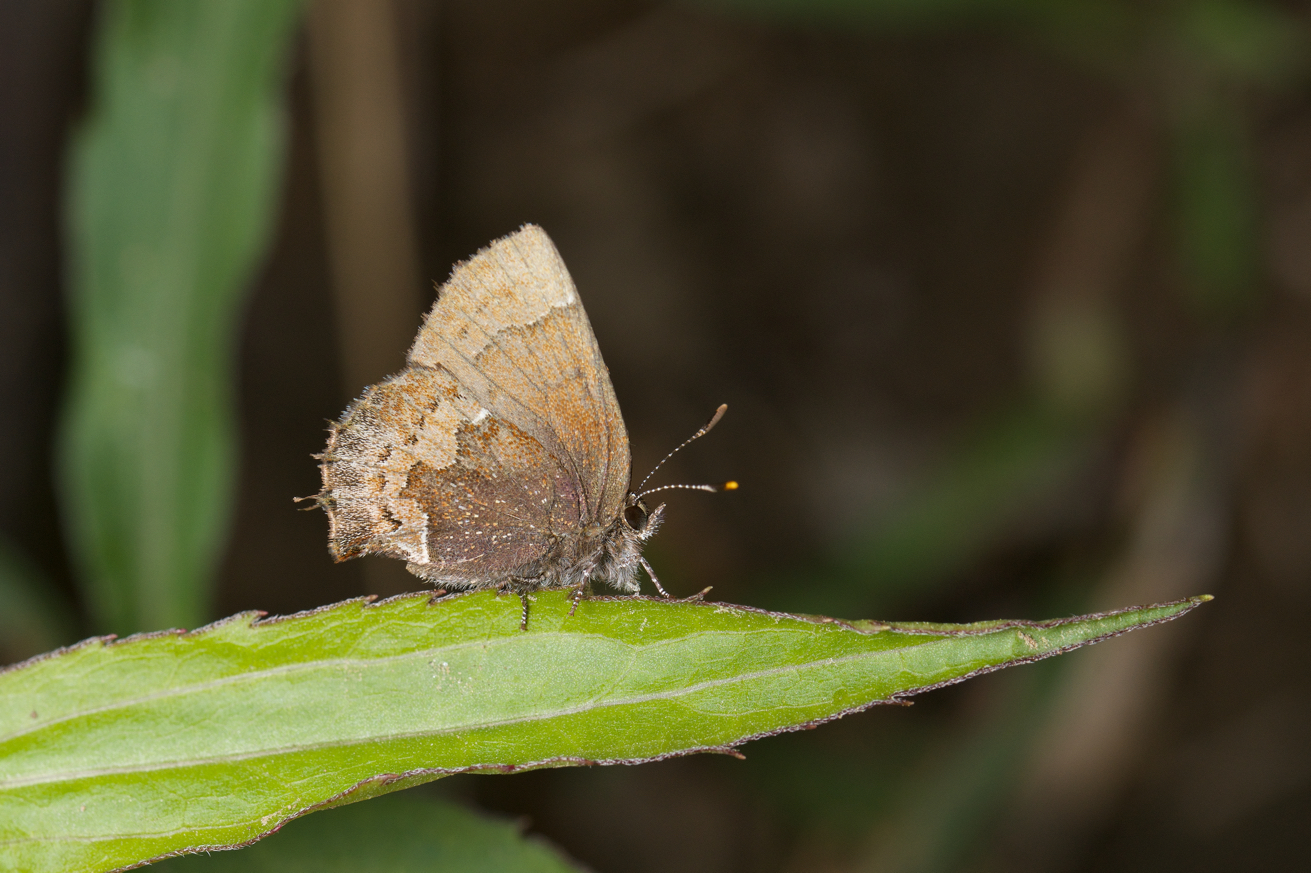Ever since finding the first and only specimen of the Cobweb Skipper (Hesperia metea) in Nebraska at this site on May 2 1989 I’ve frequently revisited this location trying to recapture lightning in a bottle (or a skipper in a net) but to no avail. But over the years I’ve found quite an interesting mix of butterflies at the south end of the Harlan County Reservoir dam. The location has some Corps of Engineers plantings mixed in with some native plants. The Corps plantings include rows of cedars, honey locusts and honeysuckle interspersed with a few lilacs. Native vegetation includes chokecherry and aromatic sumac. At this time of year the lilacs, honeysuckle, chokecherry and aromatic sumac are all in bloom and attracting butterflies. The Corps has also introduced a vetch into the area that the Wild Indigo Duskywings (Erynnis baptisiae) have taken to as a larval hostplant. So with the abundance of nectar sources and the cedars and vetch this has become my go to spot for Juniper Hairstreaks (Callophrys grynea) and Wild Indigo Duskywings.
So it was with those expectations that I made a solo (sorry, no Jonathan so no cool pics) trip to Harlan County May 5. It was sunny and in the high 60’s but there was a stiff wind from the northwest. Luckily for me my site was on the south side of a shelterbelt and I was largely unaffected by the wind. So I got to spend a couple of hours there before the clouds moved in and shut me down. While not rediscovering the Cobweb Skipper I was able to document 12 species, four of which were new for my 2020 Big Year list. I found (* indicates new for 2020) *Wild Indigo Duskywing (Erynnis baptisiae), Roadside Skipper (Amblyscirtes vialis), Tiger Swallowtail (Papilio glaucus), Marblewing (Euchloe olympia), Alfalfa Butterfly (Colias eurytheme), *Juniper Hairstreak (Callophyrs gryneus), Henry’s Elfin (Callophyrs henrici), Gray Hairstreak (Strymon melinus), *Pearl Crescent (Phyciodes tharos), *American Painted Lady (Vanessa virginiensis), Painted Lady (V. carduii), and Red Admiral (V. atalanta).
Wild Indigo Duskywings are normally difficult to find, but do fly in multiple generations (likely at least three) throughout the summer. Larval hostplants (absent an introduced vetch) would normally be various Baptisia species, and possibly also Lupines and False Lupines. This nickel to quarter sized butterfly does appear to wander a bit as I have had larvae or seen females on the Baptisia in my “urban” prairie garden here in Elm Creek. While not much to look at it is an interesting species that you can find at this site with regularity and also attract to your yard.

Juniper Hairstreak larvae feed on, you guessed it, cedars and other junipers. Adults can be found in a two flights, the first in the spring and a second in late June/July. Adults often perch on cedars and can be spooked/located by tapping cedar branches. It is an small (dime sized) but very attractive butterfly. Perhaps the greatest impediment to sighting this butterfly is just the abundance of cedars. So many cedars to look on. Even with all the cedars available this butterfly rarely is seen in numbers. This trip I saw one. A half dozen is probably the most I’ve seen here where adults seem to prefer aromatic sumac flowers.


Perhaps the most perplexing find was the rediscovery of Henry’s Elfins which were first found there in 2017. In southeast Nebraska this butterfly is normally closely associated with redbud trees, these being their larval hostplants. But Harlan County is hundreds of miles from the nearest redbud tree. A second finding here would seem to indicate a resident population using something other than redbud as the larval hostplant. James Scott (The Butterflies of North America) lists various Prunus species as possibilities. If this is the case in Nebraska this butterfly could occur anywhere. But this Harlan county site is the only spot outside of southeastern Nebraska where this butterfly has been found. Perhaps it goes unnoticed due to its small size, drab coloration and early flight period.

Henry’s Elfin – Callophrys henrici (photo from ICSP)
Olympia Marblewings are still flying and should continue for another couple of weeks before they disappear for the year so there is still an opportunity to get out and see those. We’ve also found Roadside Skippers everywhere we’ve made stops so they should not be to hard to find right now either. And keep an eye out for Henry’s Elfins as well. As always feel free to contact us at NebraskaButterflies@gmail.com with comments, questions, pics and observations.
